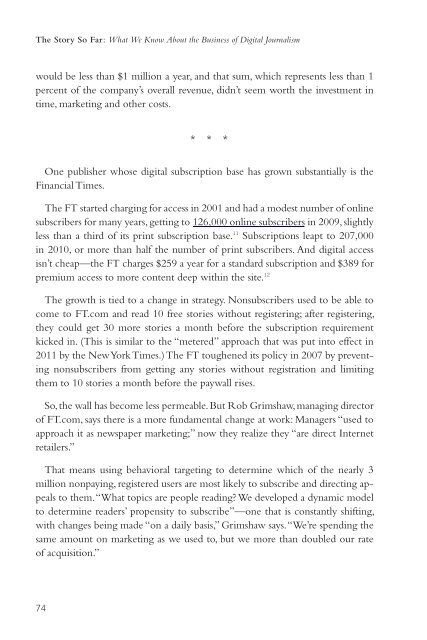What We Know About the Business of Digital Journalism
What We Know About the Business of Digital Journalism
What We Know About the Business of Digital Journalism
You also want an ePaper? Increase the reach of your titles
YUMPU automatically turns print PDFs into web optimized ePapers that Google loves.
The Story So Far: <strong>What</strong> <strong>We</strong> <strong>Know</strong> <strong>About</strong> <strong>the</strong> <strong>Business</strong> <strong>of</strong> <strong>Digital</strong> <strong>Journalism</strong>would be less than $1 million a year, and that sum, which represents less than 1percent <strong>of</strong> <strong>the</strong> company’s overall revenue, didn’t seem worth <strong>the</strong> investment intime, marketing and o<strong>the</strong>r costs.* * *One publisher whose digital subscription base has grown substantially is <strong>the</strong>Financial Times.The FT started charging for access in 2001 and had a modest number <strong>of</strong> onlinesubscribers for many years, getting to 126,000 online subscribers in 2009, slightlyless than a third <strong>of</strong> its print subscription base. 11 Subscriptions leapt to 207,000in 2010, or more than half <strong>the</strong> number <strong>of</strong> print subscribers. And digital accessisn’t cheap—<strong>the</strong> FT charges $259 a year for a standard subscription and $389 forpremium access to more content deep within <strong>the</strong> site. 12The growth is tied to a change in strategy. Nonsubscribers used to be able tocome to FT.com and read 10 free stories without registering; after registering,<strong>the</strong>y could get 30 more stories a month before <strong>the</strong> subscription requirementkicked in. (This is similar to <strong>the</strong> “metered” approach that was put into effect in2011 by <strong>the</strong> New York Times.) The FT toughened its policy in 2007 by preventingnonsubscribers from getting any stories without registration and limiting<strong>the</strong>m to 10 stories a month before <strong>the</strong> paywall rises.So, <strong>the</strong> wall has become less permeable. But Rob Grimshaw, managing director<strong>of</strong> FT.com, says <strong>the</strong>re is a more fundamental change at work: Managers “used toapproach it as newspaper marketing;” now <strong>the</strong>y realize <strong>the</strong>y “are direct Internetretailers.”That means using behavioral targeting to determine which <strong>of</strong> <strong>the</strong> nearly 3million nonpaying, registered users are most likely to subscribe and directing appealsto <strong>the</strong>m. “<strong>What</strong> topics are people reading? <strong>We</strong> developed a dynamic modelto determine readers’ propensity to subscribe”—one that is constantly shifting,with changes being made “on a daily basis,” Grimshaw says. “<strong>We</strong>’re spending <strong>the</strong>same amount on marketing as we used to, but we more than doubled our rate<strong>of</strong> acquisition.”74
















